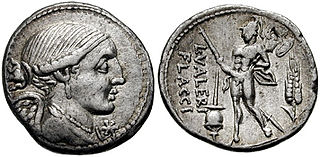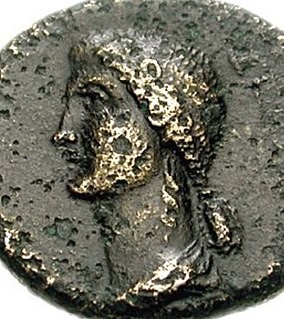Related Research Articles

The gens Petronia was a plebeian family at ancient Rome. This gens claimed an ancient lineage, as a Petronius Sabinus is mentioned in the time of Lucius Tarquinius Superbus, the last of the Roman kings, but few Petronii are mentioned in the time of the Republic. They are frequently encountered under the Empire, holding numerous consulships, and eventually obtaining the Empire itself during the brief reign of Petronius Maximus in AD 455.

The gens Valeria was a patrician family at ancient Rome, prominent from the very beginning of the Republic to the latest period of the Empire. Publius Valerius Poplicola was one of the consuls in 509 BC, the year that saw the overthrow of the Tarquins, and the members of his family were among the most celebrated statesmen and generals at the beginning of the Republic. Over the next ten centuries, few gentes produced as many distinguished men, and at every period the name of Valerius was constantly to be found in the lists of annual magistrates, and held in the highest honour. Several of the emperors claimed descent from the Valerii, whose name they bore as part of their official nomenclature.
The gens Baebia was a plebeian family at ancient Rome. The first member of the gens who obtained the consulship was Gnaeus Baebius Tamphilus, in 182 BC. During the later Republic, the Baebii were frequently connected with the patrician family of the Aemilii.
The gens Pontia was a plebeian family at ancient Rome. Few members of this gens rose to prominence in the time of the Republic, but the Pontii flourished under the Empire, eventually attaining the consulship. Pontius Pilatus, as prefect of Judaea, is known for his role in the execution of Jesus.

Milonia Caesonia was Roman empress as the fourth and last wife of the emperor Caligula from their marriage in AD 39 until they were both assassinated in 41.
The gens Afrania was a plebeian family at Rome, which is first mentioned in the second century BC. The first member of this gens to achieve prominence was Gaius Afranius Stellio, who became praetor in 185 BC.

The gens Mucia was an ancient and noble patrician house at ancient Rome. The gens is first mentioned at the earliest period of the Republic, but in later times the family was known primarily by its plebeian branches.
The gens Arruntia was a plebeian family at ancient Rome. Members of this gens first came to prominence during the final years of the Republic.
The gens Caesonia was a plebeian family of ancient Rome. They first appear in history during the late Republic, remaining on the periphery of the Roman aristocracy until the time of Nero. Roman empress Milonia Caesonia, the last wife of the emperor Caligula was presumably descended from the Caesonii, as she bore their nomen. Another family of Caesonii attained the consulship several times beginning in the late second century; it is not clear how or whether they were related to the earlier Caesonii.
Publius Memmius Regulus was a Roman senator active during the reign of the emperor Tiberius. He served as consul suffectus from October to December AD 31 with Lucius Fulcinius Trio as his colleague.
The gens Cluvia was a plebeian family at ancient Rome, known from the later Republic, and early imperial times. The first member of the gens to achieve prominence was Gaius Cluvius Saxula, praetor in 175 and 173 BC.
The gens Epidia was an obscure plebeian family at ancient Rome. The only members to achieve any importance lived during the first century BC.
The gens Rutilia was a plebeian family at ancient Rome. Members of this gens appear in history beginning in the second century BC. The first to obtain the consulship was Publius Rutilius Rufus in 105 BC.

The gens Sosia, occasionally written Sossia, was a plebeian family at ancient Rome. Members of this gens occur in history from the end of the Republic down to the third century AD. The first of the Sosii to attain the consulship was Gaius Sosius in 32 BC, and the family would continue holding various positions in the Roman state until the third century.
The gens Helvia was a plebeian family at ancient Rome. This gens is first mentioned at the time of the Second Punic War, but the only member of the family to hold any curule magistracy under the Republic was Gaius Helvius, praetor in BC 198. Soon afterward, the family slipped into obscurity, from which it was redeemed by the emperor Pertinax, nearly four centuries later.
The gens Rufria was a minor plebeian family at ancient Rome. Members of this gens are first mentioned in imperial times. Few of the Rufrii appear in history, but others are known from inscriptions.
The gens Sallustia, occasionally written Salustia, was a plebeian family at ancient Rome. Members of this gens are first mentioned in the time of Cicero, and from that time they attained particular distinction as statesmen and writers. The most illustrious of the family was the historian Gaius Sallustius Crispus, who wrote valuable works on the Jugurthine War and the Conspiracy of Catiline, which still exist.
The gens Satria was a minor plebeian family at ancient Rome. Members of this gens are mentioned in the first century BC, and under the early Empire, but none of them rose higher than the rank of praetor. Otherwise the Satrii are known largely from inscriptions.

The gens Sentia was a plebeian family at ancient Rome. Members of this gens are first mentioned in history toward the end of the Republic. The first of the Sentii to obtain the consulship was Gaius Sentius Saturninus, in 19 BC.
The gens Staberia was a minor plebeian family at ancient Rome. Members of this gens are first mentioned in the final decades of the Republic, but they never achieved much importance. The most illustrious of the Staberii may have been the Grammarian Staberius Eros, though he was a freedman. One of this family served as a military tribune in the time of Vespasian, but none of the Staberii obtained any of the higher offices of the Roman state; the consul Marcus Pompeius Silvanus Staberius Flavianus belonged to the Pompeia gens, although he was probably descended from the Staberii through a female line.
References
- ↑ Livy, Perochiae, 79.
- ↑ Granius Licinianus, 23, 25.
- ↑ Appian, Bellum Civile, i. 295.
- ↑ Broughton, vol. II, pp. 46, 50 (and notes 2, 3, 9).
- ↑ Horace, Satirae, ii. 1, 24 ff.
- ↑ CIL VI, 22933.
- ↑ Suetonius, "The Life of Caligula", 25, 33, 38, 59.
- ↑ Cassius Dio, lix. 23, 28, 29.
- ↑ Josephus, Antiquitates Judaïcae, xix. 2. § 4.
- ↑ Dictionary of Greek and Roman Biography and Mythology, vol. I, p. 558 ("Caesonia").
- ↑ CIL VIII, 5618.
- ↑ CIL XVI, 3.